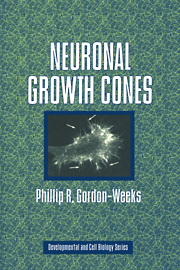5 - Synaptogenesis
Published online by Cambridge University Press: 29 August 2009
Summary
Introduction
The term ‘synapse’ was coined by the English physiologist Charles Sherrington from the Greek ‘to fasten or clasp together’ (Sherrington, 1947). He inferred the existence of a gap between neurons that contacted each other from experiments using the ganglionic blocking agent nicotine, which he painted on to peripheral ganglia. The synapse is a specialised region of close apposition between two cells where intercellular communication occurs (Burns & Augustine, 1995). Sherrington proposed the existence of a synapse from his physiological studies of the effects of nicotine on autonomic ganglia. Synapses form between neurons or between a neuron and an effector cell, such as a muscle or an endocrine cell. At the culmination of pathfinding, the growth cone must select a synaptic partner and form a synapse: a process known as synaptogenesis. In the case of most axonal growth cones, synaptogenesis requires the growth cone to stop growing and to transform into a presynaptic nerve terminal (reviewed in: Rees, 1978; Vaughn, 1989; Garrity & Zipursky, 1995; Haydon & Drapeau, 1995). Although there are presynaptic dendrites in the adult central nervous system, dendritic growth cones develop mainly into postsynaptic sites.
In this chapter, I will review our understanding of the early events in synaptogenesis, particularly the selection of a synaptic partner by the growth cone and the initial stages of the interaction between the growth cone and its synaptic partner leading to the differentiation of the synapse.
- Type
- Chapter
- Information
- Neuronal Growth Cones , pp. 160 - 173Publisher: Cambridge University PressPrint publication year: 2000



